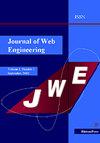结合k-Means和LightGBM改进的协同过滤Web内容个性化推荐系统设计
IF 1
4区 计算机科学
Q4 COMPUTER SCIENCE, SOFTWARE ENGINEERING
引用次数: 0
摘要
为了提高Web内容个性化推荐的精度,提出了一种结合k-means和LightGBM改进的基于协同过滤的Web内容个性化推荐系统。首先,利用Rat Swarm Optimizer (RSO)算法对k-means聚类算法(k-means)进行改进,对用户和Web内容进行聚类和分组;同时,引入光梯度增强机(Light Gradient Boosting Machine, LightGBM)算法预测用户对网页内容的兴趣程度,提出了结合k-means和LightGBM改进的协同过滤推荐方法。然后进行了仿真实验,验证了推荐方法。最后,采用B/S架构对推荐系统进行设计和测试。结果表明,结合k-means和LightGBM,改进了协同过滤推荐方法在UserBehavior数据集上的推荐MAE和RMSE分别为1.08%和2.41%,其准确率、召回率和F1分别为98.76%、98.64%和98.53%。因此,结合k-means和LightGBM改进的基于协同过滤的Web内容个性化推荐系统具有完善的功能模块,能够满足Web内容个性化推荐,具有一定的实际应用价值。本文章由计算机程序翻译,如有差异,请以英文原文为准。
Design of a Web Content Personalized Recommendation System Based on Collaborative Filtering Improved by Combining k-Means and LightGBM
To improve the precision of Web content personalized recommendation, a Web content personalized recommendation system based on collaborative filtering improved by combining k-means and LightGBM is proposed. Firstly, the k-means clustering algorithm (k-means) is improved by using the Rat Swarm Optimizer (RSO) algorithm to cluster and group users and Web content. At the same time, Light Gradient Boosting Machine (LightGBM) algorithm is introduced to predict the level of interest of users in web content, and collaborative filtering recommendation method improved by combining k-means and LightGBM is proposed. Then, simulation experiments are conducted, thus verifying the recommendation method. Finally, B/S architecture is used to design and test the recommendation system. The results reveal that MAE and RMSE of the collaborative filtering recommendation method is improved by combining k-means and LightGBM for recommendation on the UserBehavior dataset are 1.08% and 2.41%, respectively, and its precision, recall and F1 are 98.76%, 98.64% and 98.53%, respectively. Therefore, a Web content personalized recommendation system based on collaborative filtering improved by combining k-means and LightGBM has perfect functional modules, and it can meet Web content personalized recommendation, which has certain practical application value.
求助全文
通过发布文献求助,成功后即可免费获取论文全文。
去求助
来源期刊

Journal of Web Engineering
工程技术-计算机:理论方法
CiteScore
1.80
自引率
12.50%
发文量
62
审稿时长
9 months
期刊介绍:
The World Wide Web and its associated technologies have become a major implementation and delivery platform for a large variety of applications, ranging from simple institutional information Web sites to sophisticated supply-chain management systems, financial applications, e-government, distance learning, and entertainment, among others. Such applications, in addition to their intrinsic functionality, also exhibit the more complex behavior of distributed applications.
 求助内容:
求助内容: 应助结果提醒方式:
应助结果提醒方式:


